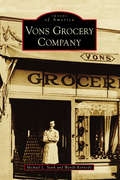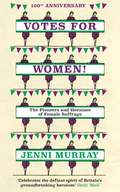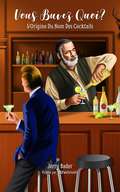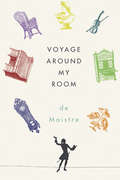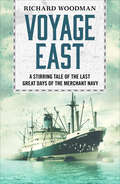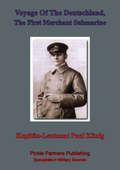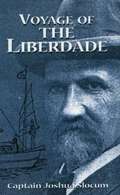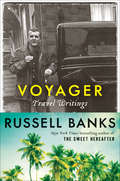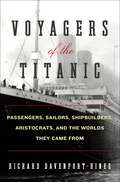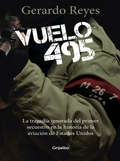- Table View
- List View
Von Neumann, Morgenstern, and the Creation of Game Theory
by Robert LeonardDrawing on a wealth of new archival material, including personal correspondence and diaries, Robert Leonard tells the fascinating story of the creation of game theory by Hungarian Jewish mathematician John von Neumann and Austrian economist Oskar Morgenstern. Game theory first emerged amid discussions of the psychology and mathematics of chess in Germany and fin-de-sicle Austro-Hungary. In the 1930s, on the cusp of anti-Semitism and political upheaval, it was developed by von Neumann into an ambitious theory of social organization. It was shaped still further by its use in combat analysis in World War II and during the Cold War. Interweaving accounts of the period's economics, science, and mathematics, and drawing sensitively on the private lives of von Neumann and Morgenstern, Robert Leonard provides a detailed reconstruction of a complex historical drama.
Vons Grocery Company (Images of America)
by Michael L. Stark Wendy KennedyIn 1906, the downtown area of Los Angeles was fundamentally a small town when Charles Von der Ahe opened his little Groceteria on the corner of Seventh and Figueroa Streets using $1,200 in savings. It was a neighborhood store that catered to the needs of local families, where Von der Ahe pioneered "cash and carry," replacing the "charge and delivery" way of thinking. Its expansion and innovation over the next 90 years was legendary, growing to more than 325 stores and 30,000 employees. This book focuses on the legacy of this great company, its visionary leaders, and its dedicated employees who made it the number one grocery retailer in Southern California.
Voodoo Dreams: A Novel of Marie Laveau
by Jewell Parker RhodesNew Orleans in the mid-nineteenth century: a potent mix of whites, Creoles, free blacks, and African slaves, a city pulsing with crowds, commerce, and an undercurrent of secret power. The source of this power is the voodoo religion, and its queen is Marie Laveau, the notorious voodooienne, worshipped and feared by blacks and whites alike. A mesmerizing combination of history, oral tradition, and storytelling, Voodoo Dreams reimagines the woman behind an enduring American legend. Jewell Parker Rhodes's novel is a memorable, magical debut.
Voodoo Queen: The Spirited Lives of Marie Laveau
by Martha WardEach year, thousands of pilgrims visit the tomb of Marie Laveau in New Orleans. In this old city she and her curse long have ruled the imagination. She has been conjured in dance, drumming, song, and necromancy. With dread and fierce affection, her celebrants ask for her favors and fearfully revere her enduring authority as "the Voodoo Queen." Who was Marie Laveau? This book about her mysterious life, magical deeds, and pervasive power recounts that there were two historical figures by this name, a mother and a daughter. They were free women of color, prominent French-speaking Catholic Creoles, and legendary leaders of a religious and spiritual tradition that orthodox faiths label as evil. From the 1820s until the 1880s, when one Marie died and the other disappeared, a mixture of gossip and devotion swirled about them.
Voodoo Queen: The Spirited Lives of Marie Laveau
by Martha WardEach year, thousands of pilgrims visit the celebrated New Orleans tomb where Marie Laveau is said to lie. They seek her favors or fear her lingering influence. Voodoo Queen: The Spirited Lives of Marie Laveau is the first study of the Laveaus, mother and daughter of the same name. Both were legendary leaders of religious and spiritual traditions many still label as evil. The Laveaus were free women of color and prominent French-speaking Catholic Creoles. From the 1820s until the 1880s when one died and the other disappeared, gossip, fear, and fierce affection swirled about them. From the heart of the French Quarter, in dance, drumming, song, and spirit possession, they ruled the imagination of New Orleans. How did the two Maries apply their “magical” powers and uncommon business sense to shift the course of love, luck, and the law? The women understood the real crime—they had pitted their spiritual forces against the slave system of the United States. Moses-like, they led their people out of bondage and offered protection and freedom to the community of color, rich white women, enslaved families, and men condemned to hang. The curse of the Laveau family, however, followed them. Both loved men they could never marry. Both faced down the press and police who stalked them. Both countered the relentless gossip of curses, evil spirits, murders, and infant sacrifice with acts of benevolence. The book is also a detective story—who is really buried in the famous tomb in the oldest “city of the dead” in New Orleans? What scandals did the Laveau family intend to keep buried there forever? By what sleight of hand did free people of color lose their cultural identity when Americans purchased Louisiana and imposed racial apartheid upon Creole creativity? Voodoo Queen brings the improbable testimonies of saints, spirits, and never-before-printed eyewitness accounts of ceremonies and magical crafts together to illuminate the lives of the two Marie Laveaus, leaders of a major, indigenous American religion.
Voracious Science & Vulnerable Animals: A Primate Scientist's Ethical Journey (Animal Lives Ser.)
by John P. GluckThe National Institute of Health recently announced its plan to retire the fifty remaining chimpanzees held in national research facilities and place them in sanctuaries. This significant decision comes after a lengthy process of examination and debate about the ethics of animal research. For decades, proponents of such research have argued that the discoveries and benefits for humans far outweigh the costs of the traumatic effects on the animals; but today, even the researchers themselves have come to question the practice. John P. Gluck has been one of the scientists at the forefront of the movement to end research on primates, and in Voracious Science and Vulnerable Animals he tells a vivid, heart-rending, personal story of how he became a vocal activist for animal protection. Gluck begins by taking us inside the laboratory of Harry F. Harlow at the University of Wisconsin, where Gluck worked as a graduate student in the 1960s. Harlow’s primate lab became famous for his behavioral experiments in maternal deprivation and social isolation of rhesus macaques. Though trained as a behavioral scientist, Gluck finds himself unable to overlook the intense psychological and physical damage these experiments wrought on the macaques. Gluck’s sobering and moving account reveals how in this and other labs, including his own, he came to grapple with the uncomfortable justifications that many researchers were offering for their work. As his sense of conflict grows, we’re right alongside him, developing a deep empathy for the often smart and always vulnerable animals used for these experiments. At a time of unprecedented recognition of the intellectual cognition and emotional intelligence of animals, Voracious Science and Vulnerable Animals is a powerful appeal for our respect and compassion for those creatures who have unwillingly dedicated their lives to science. Through the words of someone who has inflicted pain in the name of science and come to abhor it, it’s important to know what has led this far to progress and where further inroads in animal research ethics are needed.
Votes For Women!: The Pioneers and Heroines of Female Suffrage (from the pages of A History of Britain in 21 Women)
by Jenni MurrayMary Wollstonecraft, Elizabeth Garrett Anderson, Millicent Fawcett, Emmeline Pankhurst, Constance Markievicz, Nancy Astor They terrorised the establishment. They fought for the vote. They pushed back boundaries and revolutionised our world. For the hundredth anniversary of the historic moment the franchise was finally extended to women, here is a selection of suffragette and suffragist activists and pioneering MPs from the pages of Jenni Murray&’s bestselling A History of Britain in 21 Women. Set against the backdrop of a world where equality is still to be achieved, it is a vital reminder of the great women who fought for change.
Votes for Women!: American Suffragists and the Battle for the Ballot
by Winifred ConklingFor nearly 150 years, American women did not have the right to vote. On August 18, 1920, they won that right, when the 19th Amendment to the Constitution was ratified at last. To achieve that victory, some of the fiercest, most passionate women in history marched, protested, and sometimes even broke the law—for more than eight decades. From Susan B. Anthony and Elizabeth Cady Stanton, who founded the suffrage movement at the 1848 Seneca Falls Convention, to Sojourner Truth and her famous “Ain’t I a Woman?” speech, to Alice Paul, arrested and force-fed in prison, this is the story of the American women’s suffrage movement and the private lives that fueled its leaders’ dedication. Votes for Women! explores suffragists’ often powerful, sometimes difficult relationship with the intersecting temperance and abolition campaigns, and includes an unflinching look at some of the uglier moments in women’s fight for the vote. By turns illuminating, harrowing, and empowering, Votes for Women! paints a vibrant picture of the women whose tireless battle still inspires political, human rights, and social justice activism.
Vous Buvez Quao?: L'Origine Du Nom Des Cocktails
by Jerry BaderVous Buvez Quao? L'Origine Du Nom Des Cocktails Publié par MRPwebmedia Pourquoi nomme-t-on les boissons à base d’alcool ‘cocktails’? D’où tirent-ils leur nom exotique: des noms comme Singapore Sling, Screwdriver, Alamagoozlum, Angel’s Kiss, Hanky Panky, Harvey Wallbanger, Sex On The Beach, Monkey Gland, Brass Monkey, Margarita, Japalac, Lion’s Tail, et bien d’autres encore ? Qui a trouvé leur nom, où ont-ils été inventés, pourquoi, et comment les réaliser? Les réponses à ces questions se trouvent dans Vous buvez quoi? un panorama à travers des faits, personnes et lieux qui entrent dans le processus de création de ces préparations exotiques.
Vows: The Story of a Priest, a Nun, and Their Son
by Peter ManseauThe 1950s was a boom time for the Catholic Church in America, with large families of devout members providing at least one son or daughter for a life of religious service. Boston was at the epicenter of this explosion, and Bill Manseau and Mary Doherty -- two eager young parishioners from different towns -- became part of a new breed of clergy, eschewing the comforts of homey parishes and choosing instead to minister to the inner-city poor. Peter Manseau's riveting evocation of his parents' parallel childhoods, their similar callings, their experiences in the seminary and convent, and how they met while tending to the homeless of Roxbury during the riot-prone 1960s is a page-turning meditation on the effect that love can have on profound faith. Once married, the Manseaus continued to fight for Father Bill's right to serve the church as a priest, and it was into this situation that Peter and his siblings were born and raised to be good Catholics while they witnessed their father's personal conflict with the church's hierarchy. A multigenerational tale of spirituality, Vows also charts Peter's own calling, one which he tried to deny even as he felt compelled to consider the monastic life, toying with the idea of continuing a family tradition that stretches back over 300 years of Irish and French Catholic priests and nuns. It is also in Peter's deft hands that we learn about a culture and a religion that has shaped so much of American life, affected generations of true believers, and withstood great turmoil. Vows is a compelling tale of one family's unshakable faith that to be called is to serve, however high the cost may be.
Voyage Around My Room
by Richard Howard Stephen Sartarelli Joseph De Maistre Xavier De MaistreA lively and utterly singular travelogue of the intricate curiosities that are directly within one’s own reach In 1790, while serving in the Piedmontese army, the French aristocrat Xavier de Maistre (1763–1852) was punished for dueling and placed under house arrest for forty-two days. The result was a discursive, mischievous memoir Voyage Around My Room, and its sequel, Nocturnal Expedition Around My Room. Admired by Nietzsche and Machado de Assis, Ossian and Susan Sontag, this classic book proves that sitting on the living-room sofa can be as fascinating as crossing the Alps or paddling up the Amazon. In addition to the Voyage and Expedition, this edition also includes the dialogue “The Leper of the City of Aosta,” a preface by Xavier’s better-known older brother (the royalist philosopher Joseph de Maistre), and an introduction by Richard Howard.
Voyage East
by Richard WoodmanA stirring tale of life aboard ship during the last great days of the Merchant NavyNew junior officer Laddie signs on to the cargo liner Antigone on a voyage to the Far East. He finds himself part of a crew who all have their own stories to tell about life at sea.Over the course of the eventful journey to Hong Kong and Singapore, he comes to know them all, from Captain ‘China Dick’ Richards and the experienced and remote Master to the vulnerable young radio officer Sparks and the deck crew.Little does Laddie know, but this voyage will be a turning point for Antigone and all who sail in her...Perfect for fans of Patrick O’Brian and Dewey Lambdin, Richard Woodman draws upon his six years of service on ships to evocatively capture life aboard.
Voyage Of The Deutschland, The First Merchant Submarine
by Kapitänleutnant Paul KönigThe arrival of the submarine Deutschland in the harbour of New York in July of 1916 produced one of the sensation of the year. How had a U-Boat sailed all the way from Germany to the United States evading all of the counter-measures of the might Royal Navy and the even the U.S. coastal defences? The captain of the Deutschland, Paul König, was feted as a national hero in Germany and was lauded by those of German extraction in New York.He wrote this memoir of his famed journey from the inland waters of Germany all the way to the United States, it is filled with the dangers of the nascent submarine, in particular the fumes and heat of the diving compartment. Notable also the U-Boat had come as a merchantman, meaning that König was unarmed for combat and could only rely on deception to fulfill his mission to outwit his enemies.Author -- Kapitänleutnant Paul König (1867-1933)Text taken, whole and complete, from the edition published in New York, Hearst's international library co., 1916.Original Page Count - xii and 247 pages.
Voyage of the Liberdade
by Joshua SlocumIn 1890, the author became the first person to circumnavigate the globe alone. This is the account of one of his lesser-known but no less remarkable sea journeys. From the Publisher: Great 19th-century mariner's thrilling, account of the wreck of his ship off the coast of South America, the 35-foot brave little craft he built from the wreckage, and its remarkable, danger-fraught voyage home. A 19th-century maritime classic brimming with courage, ingenuity, and daring. Easy-to-read and fast-paced.
Voyage to a Stricken Land: A Female Correspondent's Account of the Tactical Errors, Wild West Mentality, Brutal Killings, and Widespread Misinformation During the War in Iraq
by Sara DanielIn June of 2002, war looms and Saddam Hussein still has a brutal grip on a nation in disarray. Sara Daniel travels the length and breadth of Iraq, following the fast-evolving events and interviewing people from all walks of life and all religious and political affiliations: from the Kurds in the north to the rising new politicians in Baghdad and beyond; from the insurgents in Sadr City and Fallujah to the police chief in Basra; from the hospital doctors tending the maimed and wounded to the directors of museums whose collections were ruthlessly pillaged; from ordinary men and women in the streets to those vying to fill the void of power; from American soldiers on deadly street patrol to the highest-ranking officers. Voyage to a Stricken Land offers a cogent, personal history of one of America's most controversial conflicts.
Voyager: Constellations of Memory
by Nona FernándezA startling book-length essay, at once grand and intimate, from National Book Award finalist Nona Fernández.Voyager begins with Nona Fernández accompanying her elderly mother to the doctor to seek an explanation for her frequent falls and inability to remember what preceded them. As the author stares at the image of her mother’s brain scan, it occurs to her that the electrical signals shown on the screen resemble the night sky.Inspired by the mission of the Voyager spacecrafts, Fernández begins a process of observation and documentation. She describes a recent trip to the remote Atacama desert—one of the world’s best spots for astronomical observation—to join people who, like her, hope to dispel the mythologized history of Chile’s new democracy. Weaving together the story of her mother’s illness with story of her country and of the cosmos itself, Fernández braids astronomy and astrology, neuroscience and memory, family history and national history into this brief but intensely imagined autobiographical essay. Scrutinizing the mechanisms of personal, civic, and stellar memory, she insists on preserving the truth of what we’ve seen and experienced, and finding ways to recover what people and countries often prefer to forget.In Voyager, Fernández finds a new container for her profound and surreal reckonings with the past. One of the great chroniclers of our day, she has written a rich and resonant book.
Voyager: Travel Writings
by Russell BanksThe acclaimed, award-winning novelist takes us on some of his most memorable journeys in this revelatory collection of travel essays that spans the globe, from the Caribbean to Scotland to the HimalayasNow in his mid-seventies, Russell Banks has indulged his wanderlust for more than half a century. In this compelling anthology, he writes that since childhood he has "longed for escape, for rejuvenation, for wealth untold, for erotic and narcotic and sybaritic fresh starts, for high romance, mystery, and intrigue." The longing for escape has taken him from the "bright green islands and turquoise seas" of the Caribbean islands to peaks in the Himalayas, the Andes, and beyond. In Voyager, Russell Banks, a lifelong explorer, shares highlights from his travels: interviewing Fidel Castro in Cuba; motoring to a hippie reunion with college friends in Chapel Hill, North Carolina; eloping to Edinburgh to marry his fourth wife, Chase; driving a sunset-orange metallic Hummer down Alaska's Seward Highway. In each of these remarkable essays, Banks considers his life and the world. In Everglades National Park, he traces his own timeline: "I keep going back, and with increasing clarity I see more of the place and more of my past selves. And more of the past of the planet as well." Recalling his trips to the Caribbean in the title essay, "Voyager," Banks dissects his relationships with the four women who would become his wives. In the Himalayas, he embarks on a different quest of self-discovery. "One climbs a mountain, not to conquer it, but to be lifted like this away from the earth up into the sky," he explains. Pensive, frank, beautiful, and engaging, Voyager brings together the social, the personal, and the historical, opening a path into the heart and soul of this revered writer."If the United States were to adopt Japan's admirable policy of designating a few extraordinary individuals as Living National Treasures, Russell Banks would be my first nomination."--Michael Cunningham"Russell Banks is a writer in the grand tradition. It is quite natural, in speaking of Banks's great works of fiction, to think of such predecessors as Conrad, Tolstoy, and Chekhov--and closer to his American home, such predecessors as Jack London, Theodore Dreiser, Hemingway, Dos Passos, Faulkner, and Nelson Algren. He has acquired an international reputation for the intensely wrought, uncompromising, and intransigent moral vision that has suffused virtually all of his work. He has created art of a kind that speaks to all classes, not merely to the elite, and yet has done so scrupulously and thoughtfully."--Joyce Carol Oates
Voyagers of the Titanic: Passengers, Sailors, Shipbuilders, Aristocrats, and the Worlds They Came From
by Richard Davenport-Hines“The story of the Titanic has been told many times; this one takes a sociological perspective, with the confident, graceful prose of fine fiction.” —Wall Street JournalIt has been over one hundred years since the sinking of the passenger liner Titanic in the North Atlantic, yet worldwide fascination with the epic tragedy remains as strong as ever. With Voyagers of the Titanic, Richard Davenport-Hines gives us a magnificent history of the people intimately connected with the infamous ship—from deal-makers and industry giants, like J.P. Morgan, who built and operated it; to Molly Brown, John Jacob Astor IV, and other glittering aristocrats who occupied its first class cabins; to the men and women traveling below decks hoping to find a better life in America. Voyagers of the Titanic offers a fascinating, uniquely original view of one of the most momentous catastrophes of the twentieth century.“Impressive in both its writing and reporting.” —USA Today“Eloquent and absorbing.” —The Telegraph (UK))“This will not be the last book on the Titanic, but it is a safe bet that there will not be a better.” —The Spectator (UK)“Bolstered by photographs of the people who built, staffed, sailed on and survived the Titanic, Davenport-Hines finds a slew of new points of view from which to scan history.” —Denver Post“Utterly compelling.” —Sunday Times (UK)“Paints a provocative portrait of the “upstairs, downstairs” social stratification in play aboard the doomed ship.” —Entertainment Weekly“An astonishing work.” —Julian Fellowes, Creator and Executive Producer of Downton Abbey“A haunting story of real, intersecting lives on a collision course with destiny.” —Kirkus Reviews
Voyageur: Across the Rocky Mountains in a Birchbark Canoe
by Robert TwiggerBest-selling author of Angry White Pyjamas travels across the Rocky Mountains by canoeFifteen years before Lewis and Clark, Scotsman Alexander Mackenzie, looking to open up a trade route, set out from Lake Athabasca in central Northern Canada in search of the Pacific Ocean. Mackenzie travelled by bark canoe and had a cache of rum and a crew of Canadian voyageurs, hard-living backwoodsmen, for company. Two centuries later, Robert Twigger decides to follow in Mackenzie's wake. He too travels the traditional way, having painstakingly built a canoe from birchbark sewn together with pine roots, and assembled a crew made up of fellow travelers, ex-tree-planters and a former sailor from the US Navy. Several had tried before them but they were the first people to successfully complete Mackenzie's diabolical route over the Rockies in a birchbark canoe since 1793. Their journey takes them to the remotest parts of the wilderness, through Native American reservations, over mountains, through rapids and across lakes, meeting descendants of Mackenzie and unhinged Canadian trappers, running out of food, getting lost and miraculously found again, disfigured for life (the ex-sailor loses his thumb), bears brown and black, docile and grizzly.
Voyageur: Across the Rocky Mountains in a Birchbark Canoe
by Robert TwiggerBest-selling author of Angry White Pyjamas travels across the Rocky Mountains by canoeFifteen years before Lewis and Clark, Scotsman Alexander Mackenzie, looking to open up a trade route, set out from Lake Athabasca in central Northern Canada in search of the Pacific Ocean. Mackenzie travelled by bark canoe and had a cache of rum and a crew of Canadian voyageurs, hard-living backwoodsmen, for company. Two centuries later, Robert Twigger decides to follow in Mackenzie's wake. He too travels the traditional way, having painstakingly built a canoe from birchbark sewn together with pine roots, and assembled a crew made up of fellow travelers, ex-tree-planters and a former sailor from the US Navy. Several had tried before them but they were the first people to successfully complete Mackenzie's diabolical route over the Rockies in a birchbark canoe since 1793. Their journey takes them to the remotest parts of the wilderness, through Native American reservations, over mountains, through rapids and across lakes, meeting descendants of Mackenzie and unhinged Canadian trappers, running out of food, getting lost and miraculously found again, disfigured for life (the ex-sailor loses his thumb), bears brown and black, docile and grizzly.
Voz que escondi
by Carolina JadueRelato en primera persona de la noche en que El Tila, conocido como El psicópata de La Dehesa, atacó a una familia completa. Carolina Jadue sobrevivió a esa noche y al trauma que vino después. Hace veinte años, la familia Jadue Zaror vivó una pesadilla. La noche del 5 de junio de 2002, su departamento en Camino El Huinganal, La Dehesa, fue asaltado por Roberto Martínez Vásquez, un delincuente de 26 años conocido como El Tila. Tras años de residencia en el Sename, El Tila asoló Santiago ese año con una seguidilla de asaltos, violaciones y asesinatos. Carolina Jadue tenía 19 años cuando se convirtió en su víctima. Estuvo al borde de la muerte y en este libro describe, con crudeza y valentía, los pormenores de esa noche, el trauma posterior y el trabajo terapéutico que ha hecho desde entonces.
Vozes Divinas e Demoníacas. Vida e Morte de Joana D'Arc.
by Borja Loma Barrie Luiza Castilho Saturnino BragaRomance histórico. Biografia. A morte na fogueira de Joana D'Arc. Vida de Joana D'Arc. História da França. História da Guerra dos Cem Anos. Carrascos da época. Como executavam as bruxas.
Vrajanatha Vadajena
by Janaki Ballabha MohantyOn the life and works of Oriya Poet Vrajanatha Vadajena.
Vuelo 495
by Gerardo ReyesEl vuelo 495 de Cubana de Aviación salió de Miami a Varadero el primero de noviembre de 1958 y nunca llegó a su destino en Cuba. A menos de dos meses del triunfo de la revolución, cinco jóvenes secuestraron el avión a nombre del 26 de Julio, el movimiento que lideraba el comandante guerrillero Fidel Castro. Llevaban armas, municiones y posiblemente dinero. Fue el primer acto de piratería aérea en la historia de Estados Unidos, con un agravante: la operación terminó en una tragedia en la que perdieron la vida más de la mitad de los pasajeros. Este siniestro quedó en el olvido y la absoluta impunidad. Sin embargo, durante más de diez años el periodista colombiano Gerardo Reyes Copello, co-ganador del Premio Pulitzer, se ha dedicado a esclarecer los hechos. Recaudó una gran cantidad de información del accidente y del fascinante contexto histórico en el que ocurrió. Habló con sobrevivientes que relataron el drama a bordo del avión y con testigos que lo vieron caer; descubrió documentos secretos inéditos y logró confrontar a uno de los sospechosos del secuestro. La historia tiene como epicentro el mundo conspirativo de Miami, una ciudad donde los sótanos de la memoria de muchos de sus habitantes están llenos de guerras clandestinas y complots que relatan abiertamente como si el tiempo lo perdonara todo. A lo largo del libro se presentan los elementos para entender la conspiración de silencio y desdén que borró de la historia el siniestro durante más de cincuenta años. Fidel aseguró que no habían autorizado la operación y su hermano Raúl anunció que llevaría al paredón a los responsables. Los lectores podrán enterarse del giro que dio el ultimátum en las páginas de esta obra periodística. English Description Cubana de Aviación’s flight 495 left Miami for Varadero on November 1, 1958, and never arrived at its destination in Cuba. Less than two months shy of the Cuban revolution, five young people hijacked the plane in the name of the 26th of July Movement, which was led by guerrilla commander Fidel Castro. They carried weapons, ammunition, and possibly money. It was the first act of air hijacking in the history of the United States, and with an additional problem: the operation ended in a tragedy that killed more than half of the passengers aboard. This disaster went forgotten and absolutely unpunished. Nevertheless, for more than ten years, Colombian journalist and Pulitzer Prize cowinner Gerardo Reyes Copello has dedicated himself to uncovering the facts.

